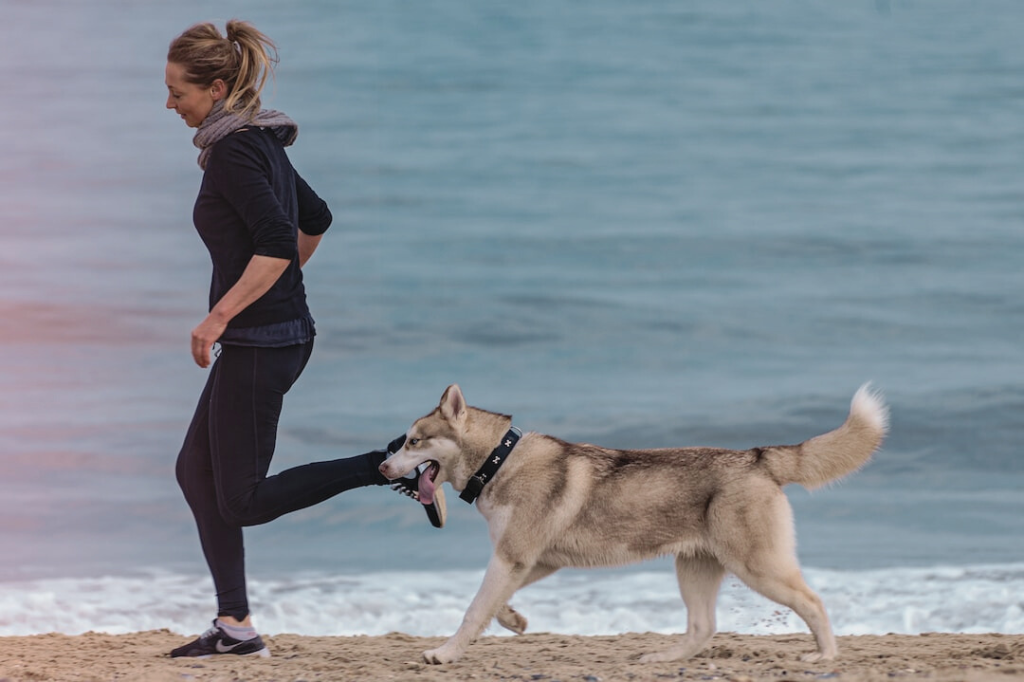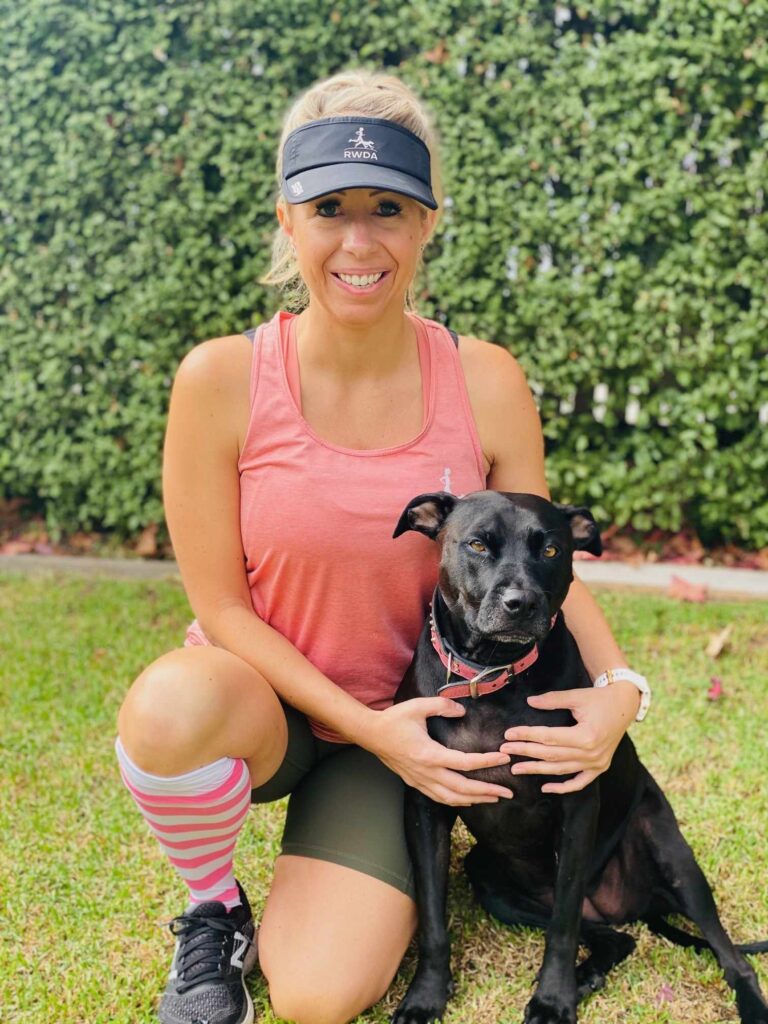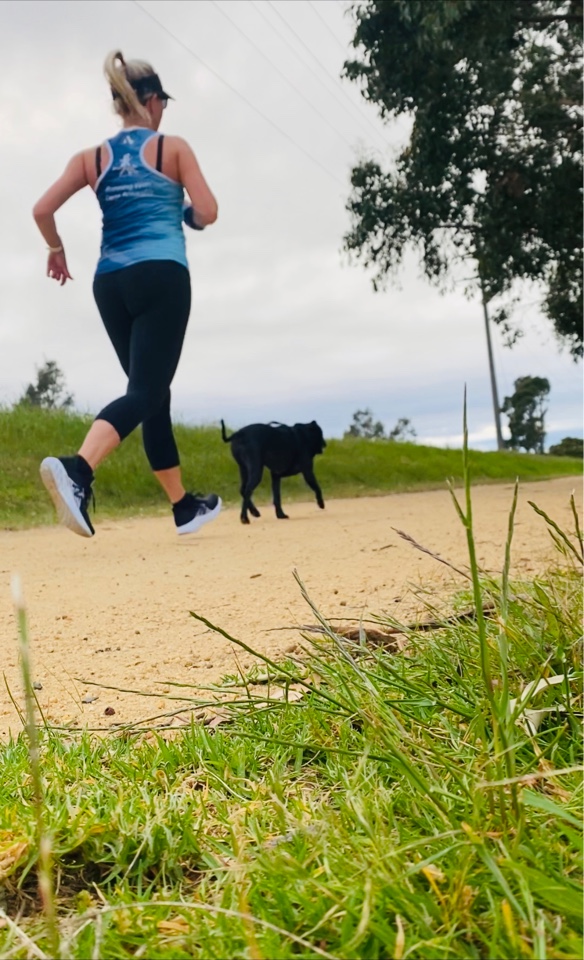

Estimated reading time: 1 minute
Running with dogs is a fantastic way for pets and their parents to spend time together while also getting in some exercise and mental stimulation.
We speak with an expert to learn why running with dogs has become so popular, the many benefits it has for you both, and the must-read tips for all beginners.

Why running with dogs is great (for you both)
Natalie Clarke from Running with Dogs Australia says running with dogs greatly enhances the bond a person shares with their pet.
“There’s no doubt dogs enrich our lives and have a remarkable bond with their humans,” says Natalie.
This bond strengthens and becomes even more evident when you go out on a run together.
“Seeing your dog’s face when you pull out their running equipment (yes they know the difference!) is priceless.”
Natalie says the excitement on her dog Gigi’s face when she knows they’re going for a run is one of the best parts.
“Gigi literally flips in the air with excitement and barks up a storm before a run.
“The joy on her face is so extreme that she almost guilts me into running with her each week.”
Natalie says dogs are a great motivator for their owners to get out and hit the pavement.
“As much as I love running for my own personal reasons, she’s become a great motivator for me to keep getting up when I’m a little tireder than usual or if the weather isn’t so nice,” she adds.
“Many of our members can also relate to this; our dogs’ loyalty, affection and boundless energy are great motivation and serve as inspiration to keep up our fitness.”
How it began
Natalie launched Running with Dogs Australia after losing her running partner, border collie Bella, in 2016.
“I enjoyed running with a dog by my side and realised it gave me a sense of comfort and purpose and was far more enjoyable than pounding the pavement alone,” she says.
“I felt at a loss without her and during that void, wanted to bring like-minded people together.
“At the time there wasn’t much information available online and I wanted to increase awareness about this sport/hobby for others and share what I had learnt myself over the years.
Seven years on, Natalie has learnt a lot about the sport she loves, and she turned her passion into an education tool for others.
“I now run with dedicated running equipment for myself and Gigi, and I’ve learnt far more about the right time to feed my dog and other ways I can look after her health.
“We now have over 2,300 members in our Facebook group which is a great community to ask questions and learn more about what we love and enjoy.
“By sharing information, we can all make running with dogs safer and more enjoyable.”


Running with dogs: tips for beginners
Natalie stresses that for anyone wanting to start to run with their dog, the most important factor is their health.
“The very first step is to ensure your dog has a clean bill of health from a veterinarian,” says Natalie.
“One who is supportive of your goal to enjoy fitness with your dog.
“Key to a safe and enjoyable run is having a dog who is physically healthy and at a suitable age to start, and that the dog is not being subjected to ‘forced exercise’.”
Running With Dogs Australia has compiled a comprehensive guide that they share with everyone starting out with them.
“(the guide) takes you through all the necessary steps you should consider before starting your running journey.”
Natalie says that while there are many safety factors in their guide, training a dog well is one of the most important.
View and download the Running with Dogs Australia guide here
And, as no two dogs are built the same, it’s also important to factor in a dog’s energy levels.


“As owners, we know our dogs the best and it is our responsibility to monitor them constantly and adjust our runs according to their behaviour and needs.
“Having a well-trained dog is key to having an enjoyable run.
“If you have a dog with high energy levels, you may need to temper that energy with a walk or play before you start your journey.
“Or, you may add a play and or swim stop in during your run so your dog has the chance to burn off that excess energy.”
Owners should also adjust their exercise to suit dog’s that have less energy and may not suit a long run or a certain course.
“Should you have a dog with lower energy levels, it is important to cater to this and to not push them beyond their capabilities,” Natalie stresses.
“This may mean dropping them at home and taking them on a shorter run, and you continuing on without them.”


What you need to start
Anyone wanting to run with their dog should research accessories that increase safety and security.
And, Natalie explains, it’s important to invest in the right running equipment for both.
“The first reason for this is to differentiate your run from your walk with your dog,” she says.
“(that way) when you pull out your running gear, your dog knows he or she is about to go on a run rather than a walk.”
Special running equipment also helps ensure the runner maintains the correct posture.
“We highly recommend you use a well-padded good quality harness for them that does not restrict their shoulder movement.
“The harness ideally connects to a bungee leash around your waist(that) absorbs shock if your dog suddenly pulls you.
“Being hands-free ensures your mobility and style isn’t compromised and your dog is not tugged on around the neck.”
And, Natalie says it’s important to include some breaks to keep dogs engaged and happy during the run.
“This may entail a stop down at a beach or park for a play.
“You may even have a favourite water stop where your dog can cool off and have a splash around.
“If engagement needs to further increase, you may consider varying your route or hitting some off lead trails. Just make sure that recall command is well and truly established!”
Risks and dangers to avoid while running with your dog
Making a dog exercise before they are physically ready is extremely harmful to their health and development.
“The health of our dogs is paramount,” says Natalie.
“So you should not engage a dog in exercise before their bodies have had the chance to mature.
“Growth plates are softer than other parts of the bones and are therefore more prone to injury.”
Again, it’s important to seek veterinary advice prior to starting any running program with a dog.
Every breed, and every dog, is different so there is no set rule for age they can start to run.
That’s why it’s important to chat with a vet to discuss the appropriate time to begin.
And, Natalie says, it’s best to speak with a vet with experience or knowledge of running with dogs.
“Older dogs may have health problems which may not make them suitable running partners.
“While large breeds can be prone to hip dysplasia,” she explains.
“Your vet can evaluate your dog for any heart, lung, or other health problems.
“It’s important your dog has a clean bill of health before you start them out as a running buddy.
“Just like humans, dogs need to build on their fitness,” Natalie stresses.
“So dog owners should not expect their dog to run 5km’s on their first run.
“Strength and endurance should be built gradually so you may consider a running program such as Pooch to 5K.”
Events for pooches and their parents
For those interested, there’s a number of different running with dogs events across Australia.
And there’s also some adventure races to enter that help raise money for animal welfare organisations.
“We always share dog-friendly running events to our members, but our annual run in Gruyere Victoria is Adventure Dog.
“Our members have participated in this event, run by Animal Aid, since it first began in 2017.
“We welcome new members to join us for some muddy fun in a cross-country challenge,” she says.
“That helps raise much needed funds for unwanted and abandoned animals in our community.”
